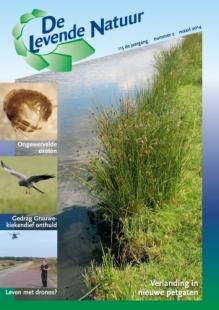De Levende Natuur nummer 2 van 2014 (English summary)
Afbeelding

Terrestrialization in reexcavated peat turbaries in the Vecht area (Netherlands)
W.A. Weijs & B.F. van Tooren
Peat excavation in the past left linear ponds (turbaries or ‘petgaten’), that subsequently terrestrialized, forming fen vegetation. In the Vecht area species rich mesotrophic floating fens developed under the influence of groundwater discharge from the adjacent ice-pushed Pleistocene ridge. Due to stopping of agricultural use (mowing, wood cutting) most of these have now turned into alder carr. Since 1989, 39 ponds, mostly former peat ponds, have been (re)excavated in the study area to reset the succession. In 2012 the level of nutrients and supply with groundwater of half of these was found to be insufficient to support new terrestrialization, mostly due to replacement of ground water by rain or surface water. Vascular plants and Desmidiaceae had developed poorly. Only in 5-6 ponds a diverse aquatic flora had been formed and terrestrialization started; in two cases typical mesotrophic floating fen species had made their appearance. The shallow water was not invaded via floating vegetation mats, but by helophytes, extending down the gently sloping banks. We conclude that the chances for successful restoration will increase by stricter selection of locations where the attainment of good water quality can be ascertained, and by constructing narrow ponds with gently sloping banks and a somewhat irregular form.
Fitting in or displace? The influence of non-indigenous species on freshwater invertebrate communities
R.C.M. Verdonschot & P.F.M. Verdonschot
Non-indigenous invertebrates are common in fresh waters in The Netherlands. In total, 67 species are recorded, of which 46 are found in the regular monitoring carried out by local water authorities. To study their impact on the native macroinvertebrate assemblages present in these waters, all data collected over the last three decades were analysed. Approximately 60% of the sampling locations contained one or more non-indigenous species. The degree of connectivity, expressed as stream order, strongly influenced the total number of non-indigenous species recorded in a water type. Furthermore the trophic state of the watertype explained the remainder of the variance in non-indigenous species richness among water types. A comparison of total taxon richness, the number of taxa indicating good ecological quality and the number of non-indigenous species in samples taken from different water types showed that in buffered drainage ditches, slowly-flowing middle and lower courses of lowland streams and in rivers a relatively high number of non-indigenous species was observed in samples with a high number of indicator species and a high total richness. This indicated that in these systems the non-indigenous species were fitting in the already present macroinvertebrate assemblage instead of displacing indicator species or disrupting the whole community.
Marine reserves in the Dutch North Sea: what are we actually protecting?
H.J. Lindeboom
For the Dutch part of the offshore North Sea, three areas have been designated as Natura 2000 Marine Protected Areas. Management plans are now developed, in consultation with stakeholders such as fishery organizations and NGOs. However, small uncontrollable sub-areas are created. If we want to restore biodiversity and food webs in areas such as the Cleaver Bank, it is recommended to protect larger areas and not just the stones. We can learn a lot from the Australian Great Barrier Rif. Here after 30 years of protecting exclusively coral reefs leading to little results, at least 20% of all types of habitats has been protected in large areas since 2004. This led to significant increases in fish abundance and bigger fish.
Tracking Montagu’s Harriers using UvA-BiTS GPS-loggers for conservation
R.H.G. Klaassen, A. Schlaich, M.S. Franken, W. Bouten & B.J. Koks
North-eastern Groningen, The Netherlands, holds a stronghold of Montagu’s Harriers (Circus pygargus), which established in this intensive agricultural landscape in 1990-1993 when large scale set-aside habitat was introduced. Nowadays the population relies on agri-environmental schemes (AES), such as set-aside field edges. We tracked breeding males using state-of-the-art GPS-loggers to reveal habitat use and behaviour, in order to understand why AES work for this species, and in what way they can be improved (adaptive nature conservation). We found that harriers strongly select for AES and other set-aside habitat, but that only about 5% of their total hunting time was spend in this habitat, despite the fact that vole numbers, the main prey of Montagu’s Harriers in our study area, were more abundant in set-aside habitat than in for example grass, the habitat mostly used by harriers. Possibly prey availability rather than prey abundance determines habitat use. This idea coined a novel form of AES, in which strips of set-aside habitat were combined with strips of Alfalfa. In this way not only high densities of prey are produced, but also made available when Alfalfa is harvested.

